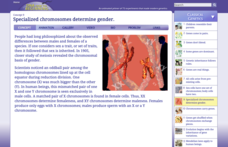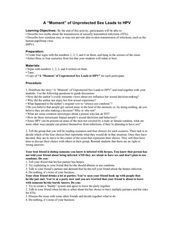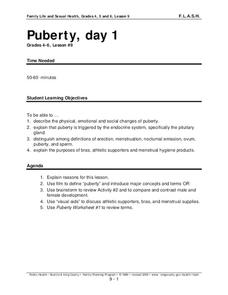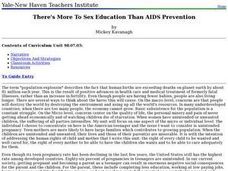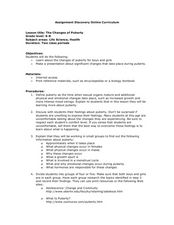Curated OER
Anatomy and Physiology
Fifth graders work in teams to play a game enabling them to identify the basic components of the female human reproductive system. They view an overhead that describes menstruation and discuss their knowledge of the female reproductive...
Curated OER
What Happens in the First Nine Months?
Students explore human development using Internet resources that contain text, drawings, photos, and video about human development. They research a trimester of pregnancy then create drawings to show what is happening to the fetus during...
Oklahoma State University
Hairy Heredity
Young scholars learn that heredity comes down to the flip of a coin with this cross-curricular math and science lesson. Using smiley faces as a model, young scholars toss coins to determine which dominant or recessive...
Curated OER
Sexual Exploitation: Day 2
Young scholars evaluate human psychology by answering sexual health study questions. For this exploitation lesson, students identify the main causes for sexual assault, the best ways to deal with it at the time and how to prevent it from...
Curated OER
Sexually Transmitted Diseases: Lesson 4
Students participate in a class discussion which includes categorizing sexually transmitted diseases into various groups such as "always have symptoms/often don't have symptoms" and "curable vs. not curable" to reinforce the idea of...
Curated OER
Sexually Transmitted Diseases: Overview
Students observe human heath by completing a worksheet in class. In this STD lesson, students identify the different types of diseases which are spread through sexual intercourse and what symptoms will become noticeable. Students...
Curated OER
TE Lesson: What's Dominant?
Students study the number of chromosomes in the body cells, sperm cells, and egg cells of humans. They define allele, and examine the difference between dominant and recessive alleles. They complete an activity with jelly beans that...
Curated OER
Reproduction, Day 3: Parenthood
Reproduction can result in parenthood. Discuss the pros and cons, responsibility, and possible results of sexual intercourse. Intended for a secondary special education class, this lesson is developmentally appropriate for mild to...
American Psychological Association
Research Ethics
Psychologists designing experiments to research human behavior must consider weighty ethical concerns. Class members act as members of an institutional review board and examine proposals to determine whether included provisions...
Curated OER
Why Do People Fall in Love?
Students discuss human behavior, sexual selection and the underlying genetic and evolutionary reasons for mate selection. The, in groups, they rate the attractiveness of certain individuals and measure facial features for symmetry.
Curated OER
Taking Care of a Baby
Caring for a newborn is harder than it looks! Elementary pupils learn more about taking care of babies with an age-appropriate lesson that addresses how babies grow inside their mothers, what they need to grow, and how members...
Curated OER
Journal of Sex Research
Learners increase understanding of how families, through their heredity, structure, and relationships may increase or decrease the likelihood of adolescents engaging in sexual and contraceptive behavior.
Curated OER
Human Heredity Vocabulary
Ninth graders review the terms "aneuploidy," "fetus," and "karyotype" in this vocabulary activity, which includes three multiple choice questions about each term. This activity could be expanded into a more developed vocabulary lesson in...
Cold Spring Harbor Laboratory
Specialized Chromosomes Determine Gender
Are you an XX or an XY? Budding scientists learn about cellular fertilization and the determination of gender in a thorough online lesson. They follow their study with a set of interactive reflection questions.
Missouri Department of Elementary
Healthy Touches and Private Touches
Scholars identify the difference between healthy touches and private touches. A discussion leads pupils to recognize several trusting adults. Peers role-play scenarios in which they use three rules to remain safe.
Curated OER
A "Moment" of Unprotected Sex Leads to HPV
In a health class, participants read a story about a young woman who contacted HPV. The story is not included in the lesson plan, but is easily located on the Internet. The teacher then describes different scenarios for individuals to...
Curated OER
Puberty
Students investigate life science by answering maturity questions. In this human health lesson, students identify the changes which occur during puberty and answer study questions based on sexual awareness. Students define scientific...
Curated OER
Meiosis, Gene Linkage and Maps
Young scholars identify the structures that actually assort independently. They are taught how gene maps are produced. Students compare the processes of mitosis and meiosis. They are shown their (mitosis and meiosis) significane to...
Curated OER
There's More To Sex Education Than AIDS Prevention
Students are introduced to the views on sexuality in the United States. In groups, they research data from five countries and compare them with the United States. Using the information, they develop reasons why the teenage pregnancy...
Curated OER
The Changes of Puberty
Students study about the changes of puberty for boys and girls. In this health instructional activity, students study how the body changes during puberty and make a presentation about a significant change that can take place during...
Curated OER
Life Cycle
Seventh graders make a collage of the human life cycle. In this life cycle lesson students study the human reproductive system and the general concepts of pregnancy. Students receive detailed information about the human life cycle and...
Curated OER
Populations – The Survival of the Fittest (Part 1)
Students explain in their own words why organisms live together. In this biology lesson, students model what happens to organisms if their environment changes. They explain the importance of evolution.
Curated OER
Justice Demands an End to Segregation, But it Does Not End
Learners define human rights and describe how it applies to politics, economics and cultural rights. As a class, they watch a video how the Constitution was made and discuss its purpose. In groups, they present information to the class...
Curated OER
HIV/AIDS: Basic Facts
Students investigate human sexuality by researching STD's. In this HIV lesson, students discuss the potential risk of getting a sexually transmitted disease such as HIV which can cause illness and death. Students assess their own...













